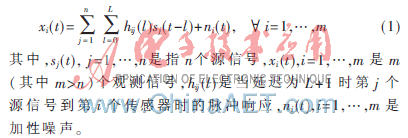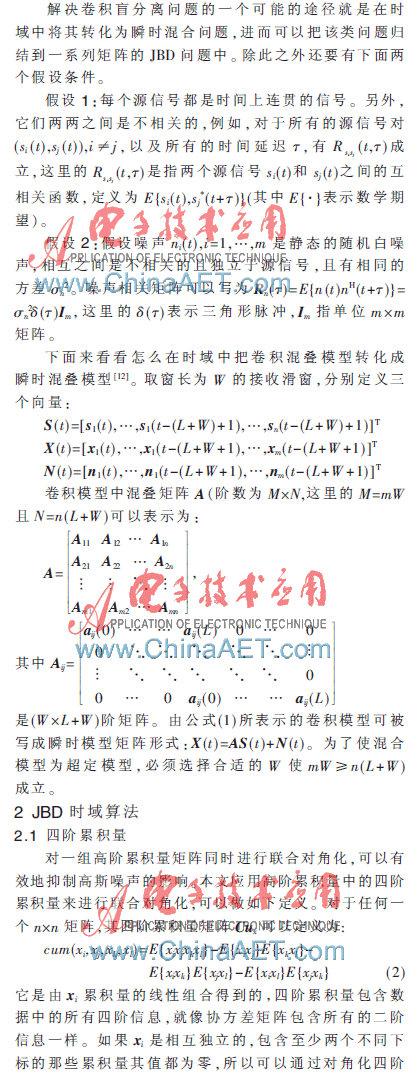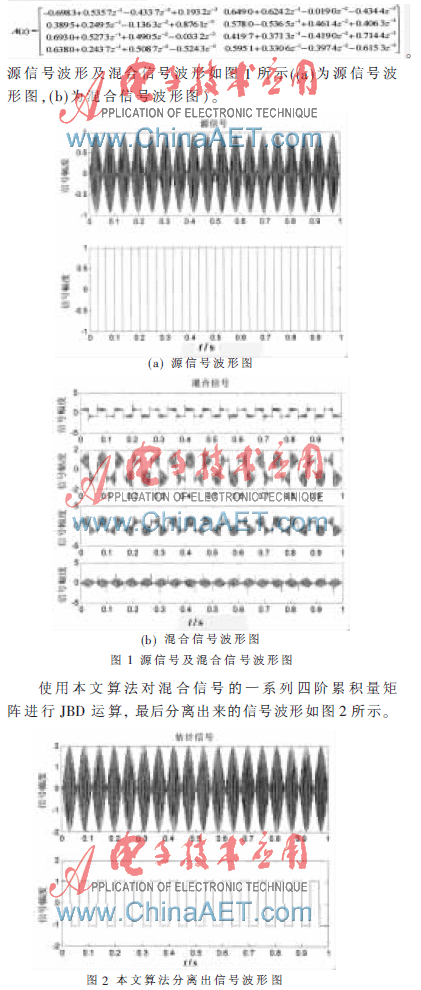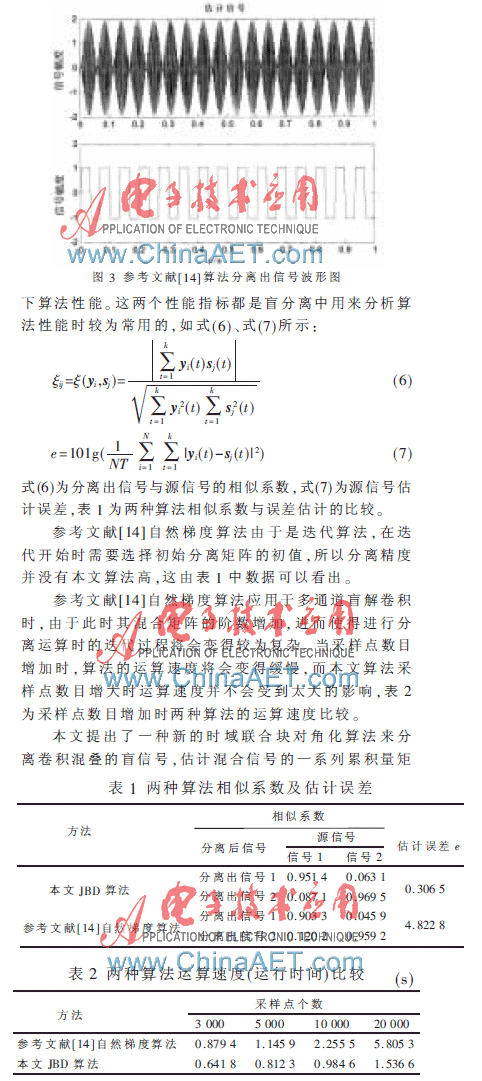文献标识码: A
文章编号: 0258-7998(2012)02-0101-04
近年,盲信号分离BSS(Blind Source Separation)的研究已经成为信号处理领域的一个研究热点,涌现出许多盲分离的算法。盲信号分离是在源信号和传输信道参数未知的情况下,仅根据源信号的统计特性,从观测信号中分离源信号的过程[1]。盲信号分离所研究的混叠模型主要分为瞬时混叠和卷积混叠两类。瞬时盲分离已经得到广泛而成熟的研究,联合块(JBD)对角化是解决瞬时盲分离的有效方法[2-4]。然而,传感器接收到的信号通常是源信号与多径传输信道的卷积混叠信号,这使得卷积盲分离受到越来越多的关注[5-7]。
与瞬时混叠模型相比,卷积混叠信号模型及其求解更为复杂。在现有方法中,基于高阶统计量的时域算法[8-9]是解卷积混叠盲信号分离问题的一类直观且有效的方法。作为时域算法,它不需要解决频域算法[10-11]中所固有的又不得不解决的尺度模糊和排列模糊问题;同时,对一组高阶累积量矩阵同时进行JBD又可以有效地抑制高斯噪声的影响。鉴于这两点,本文提出一种基于高阶累积量的JBD时域算法,来解决卷积混叠盲信号分离问题。
1 问题描述
盲信号分离的目的是把通过一未知混合系统后的观测信号分离开来。在卷积混合情况下,假设源信号通过一个线性有限脉冲响应FIR滤波器,也就是说观测信号是由它们的延迟所组成的线性组合,即:




用参考文献[14]中所提到的自然梯度算法来分离卷积混合的源信号,最后分离出来的信号波形如图3所示。
从两种算法分离出的信号波形图中很难明显看出其性能的差别,下面通过两个性能指标来客观地分析一

阵。在此基础上通过使代价函数最小化的方法来使累积量矩阵成为块对角矩阵,进而实现盲分离。计算机仿真结果表明,本文算法与自然梯度算法相比有分离精度高及分离速度快的特点。
参考文献
[1] HAYKIN S. Unsupervised adaptive filtering, vol I: Blind source separation[M]. New York: Wiley Press, 2000:21-23.
[2] SIDIROPOULOS N D, BRO R, GIANNAKIS G B. Parallel factor analysis in sensor array processing[J]. IEEE Trans Signal Process, 2000,48(8):2377-2388.
[3] VANDER V A J. Joint diagonalization via subspace fitting techniques[A].In Proc.ICASSP’01[C]. Piscataway,NJ:IEEE Press, 2001:2773-2776.
[4] ARIE Y. Non-orthogonal joint diagonalization in the leastsquares sensewith application in blind source[J]. IEEE Trans Signal Process, 2002, 50(7):1545-1553.
[5] ABED-MERIAM K, BELOUCHRANI A. Algorithms for joint block diagonaliztion[A]. In Proc. EUSIPCO’04[C]. Vienna:EURASIP Press,2004:209-212.
[6] FEVOTTE C, THEIS F J. Orthonormal approximate joint block diagonalization[R].Technical Report GET/Télécom Pairs, 2007D007, 2007.
[7] 胡可,汪增福.一种基于时频分析的语音卷积信号盲分离算法[J].电子学报,2006,34(7):1246-1254.
[8] BUCHNER H, AICHNER R, KELLERMANN W. A generalization of blind source separation algorithms for convolutive mixtures based on second-order statistics[J]. IEEE Transactions on Speech and Audio Processing, 2005,13(1):120-134.
[9] GHENNIOUI H, FADAILI E M, MOREAU N T, et al. A nonunitary joint block diagonalization algorithm for blind separation of convolutive mixtures of sources[J]. IEEE Signal Processing Letters, 2007,14(11): 860-863.
[10] SAWADA H, MUKAI R, ARAKI S, et al. A robust and precise method for solving the permutation problem of frequency-domain blind source separation[J]. IEEE Transactions on Speech and Audio Processing, 2004,12(5): 530-538.
[11] HE Z S, XIE S L, DING S X, et al. Convolutive blind source separation in the frequency domain based on sparse representation[J]. IEEE Transactions on Audio, Speech, and Language Processing, 2007,15(5):1551-1563.
[12] GOROKHOV A, LOUBATON P. Subspace based techniques for second order blind separation of convolutive mixtures with temporally correlated sources [J]. IEEE Trans.Circuit Syst., 1997,44(9):813-820.
[13] BOUSBIAH-SALAH H, BELOUCHRANI A,ABED-MERAM K. Jacobi-like algorithm for blind signal separation of convolutive mixtures[J]. Electron. Lett.,2001(37):1049-1050.
[14] AMARI S, DOUGLAS S, CICHOCKI A,et al. Multichannel blind deconvolution and equalization using the natural gradient[J]. In Proc. 1st IEEE Workshop Signal Processing Advanced Wireless Commun., Paris, France, 1997(4):101-104.

